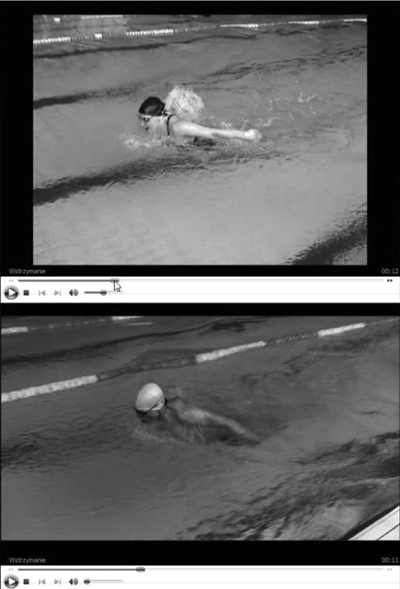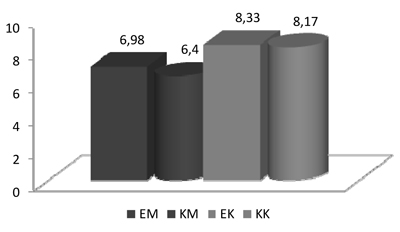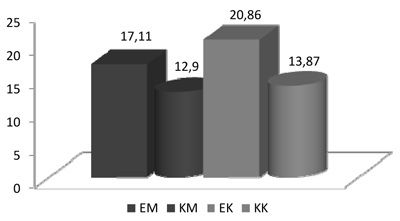The Role of Visual-Verbal Information Transfer in Teaching Swimming
Фотографии:
ˑ:
Dybińska Ewa1, professor
Kaca Marcin1,
Tadeusz Ambroży1,
Dorota Ambroży1,
Dariusz Mucha1
1Sport Institute - Department of Water Sports, University School of Physical Education, Cracow, Poland University School of Physical Education, Krakow, Poland
Key words: visual-verbal information, learning and teaching swimming activities, efficiency of teaching method.
Introduction. In the process of teaching and learning motor skills comprised in constant flow of information between teacher and learner [1] didactic communication gains special meaning. Information transferred by the system of visual, verbal and sensory signs, thanks to influence on sight, hearing and sensory receptors, can effectively influence developing motor notions and the efficiency of mastering motor activity [2, 4, 8].
Information flowing between sender and receiver has to fulfill, though, a series of determinants deciding about the effectiveness of the transfer [6, 7, 9]. Since, on the one hand, a complex way (information channel) covered by every piece of information (sender, collection of signs, signal, decoder, receiver) influences the effectiveness of its transfer, where even at the stage of creating the message (system of signs) an error may occur (interference) causing divergences to appear between intention of sender's utterance and coded contents. On the other hand, receiver of the information has to process in consciously (selection, association, reasoning, plan-making) before he makes a right decision to perform a motor activity [11]. Image and word, thus means of conveying information, used in teacher's explanation of any taught motor skills, play a basic role in didactic communication. That is why the development of notion connected with the transfer of visual and verbal information in the process of teaching swimming skills contributed to particular consideration either quantity and (above all) quality of transferred message [3, 5]. A technical development noticed a long time ago and used successfully by Physical Education teachers in shaping students' cognitive sphere turned out to be motion pictures, that is didactic films. Using video or digital ways of recording images is currently a common element in the realization of didactic processes [9]. Apart from didactic film, a medium more and more frequently implemented is the analyses of recordings which pose the function of feedback information, contributing to increasing the effectiveness of student's and teacher's activities [7, 10]. Thanks to feedback information, along with the usage of video techniques, a more efficient control and assessment of a didactic process is possible.
The issue of the search of such developments inspired authors of the thesis to conduct research on the meaning of transfer of visual-verbal information, with the use of audiovisual means of conveying information, on the effectiveness of the process of learning and teaching motor skills on the example of swimming.
The purpose of the present paper was to define the relations between the conveyed visual-verbal information transfer with the use of modern audiovisual methods, and estimate efficiency of learning and teaching to swim on the example of students being educated in the field of motor skills.
Materials and methods. The research was conducted in the year 2009/2010 among male and female students of the first year of University of Physical Education in Cracow. Generally, 76 persons were subjects of observation, 33 women and 43 men. In the research the authors used the method of natural pedagogical experiment with the use of the technique of parallel groups: experimental (E) and control (K). The aim of the teaching method and mastering swimming skills was learning the butterfly technique on a standard level by the students. Conditions of realization of the experiment in both groups (E and K) were the same. The contents of teaching included the same agenda premises which were accomplished within 6 forty-five minute lessons (once a week) taught by teachers with the same professional competence and comparable work experience. A dependent variable in the experiment was presented by the results of mastering the level of butterfly in research groups (E, K). In the experiment shown (while selecting students to experimental groups) the only people taken into account were those men and women who presented similar level of mediating variables, that is did not show statistically essential differences either in the level of motor (coordination) skills and the level of intelligence and frequency.
An operand, that is the experimental factor in the research done was the method of teaching consisting in influencing the cognitive sphere with the use of enhanced transfer of visual and verbal information in experimental group (E) in relation to traditional didactic activities in control group (K). In the control group (K) in the process of teaching butterfly the transfer of information was done by means of: verbal methods –description, explanation, instruction, commentary; visual methods – demonstration, display, visual charts, didactic films and methods of practical activities (kinesthetic information). In experimental group (E) apart from traditional (above mentioned) methods of transferring information the authors introduced during the classes additional didactic activities, which were taking into account the transfer of visual and verbal information, comprising in equipping students in materials including: model images with an instruction and commentary (multimedia presentation) on the structure and trajectory of movements of the taught butterfly technique (on a standard level) and video recordings concerning swimming skills learned by the student in the context of model technique which is described in didactics as parallel demonstration – comprising in confrontation of the model with actual level of student's skills, which in turn enabled the subject to do self-assessment on the basis of self-observation (Fig. 1).
The test was carried out according to the following premises: 1. the subject covered a distance of 50 m by butterfly (individually on a separated track) and in that time his skills were video recorded by means of video camera, 2. scoring results of the analysis were recorded in scorecards of “Criterial Test of Skills”. The amount of possible score gained in the area of butterfly varied from 0 to 26 points. A proper (flawless) performance of the whole motor sequence was expressed by a number equal with the quantity of distinguished components in a given swimming technique.

Fig. 1. Parallel show – pattern and subject (picture on CD)
To assess the results of the influence of experimental factor there were measurements done in both groups (E and K) of size of dependent variables (the level of swimming skills): in research I – pretest – at the beginning of the teaching process, and in research II – post-test – at the end of the process.
The results of the research were studied according to the following methods of statistics: Test T – Student for independent trials, U Manna-Whitney's Test in order to determine differences between groups E and K in the case of distribution of data differing from normal and the optional analysis with repeated measurements was used. The authors used STATISCICA 6.0 software from StatSoft in order to do statistical calculations.
Results and discussion. In order to assess the level of swimming efficiency in research groups, experimental (E) and control (K), “Criterial Test of Skills” was used, whose results were expressed in points. The results of the first research (pretest) and the second research (post-test) in experimental and control group among women and men was presented below.

Fig 2. Arithmetical average of pretest results women and men (KTU pts.)
Table 1. Differences between pretest results in group E and K (women and men) – using the optional analysis with repeated measurements
|
Groups |
PRETEST |
||
|
F |
df |
P |
|
|
KM- EM |
0.93 |
1. 41 |
0.34 |
|
KK- EK |
0.1 |
1. 31 |
0.75 |
*p<0,05, **p<0,0
The results (Table 1, Fig. 1) concerning the comparison of level of skills of butterfly technique in the research I (pretest) between experimental and control group of female (KK-EK) and male (KM-EM) reveal lack of statistically essential differences in the observed variable. Thus, the subjects in groups E and K at the beginning of the process of learning and teaching showed equal level of starting skills of swimming butterfly.

Fig. 3. Arithmetical average of posttest results women and men (KTU pts.)
Table 2. Differences between posttest results In group E and K (women and men) – the optional analysis with repeated measurements was used
|
Groups |
POSTTEST |
||
|
F |
df |
P |
|
|
KM- EM |
15.84** |
1.41 |
<.01 |
|
KK- EK |
34.74** |
1.31 |
<.01 |
*p<0,05, **p<0,01
Doing statistical comparisons between experimental (EM, EM) and control (KK, EK) group of men and women, and comparisons concerning skills of swimming butterfly in research II (post-test – at the end of the experiment) (Fig. 2, Table 2), it was stated that among either women and men statistically essential differences occurred (p<0.01 i p<0.05) in the level of the dependent variable, to the advantage of experimental groups.
The authors of the experiment, trying to taking into account premises coming from existing knowledge of optimization of information transfer were also concentrated on didactic activities, comprising in assessment of the results of teaching by teacher and student and auto-observation and self-assessment done by the student (using Criterial Test of Skills and parallel display). The activities took place on the basis of video recordings and with the use of available audiovisual devices (computer programmes, portable computer, cameras). The Internet and CD-RW constituted, in turn, and element fulfilling contemporary (modern) didactics towards the rule of availability or mobile learning (m-learning). The basic aim of the conducted experiment was an attempt to assess relations between implemented method of enhanced transfer of visual and information and the effectiveness of mastering a motor skill, which is butterfly technique, by adults.
Doing statistical comparisons (by the means of alternations analysis with repeated measurements) between experimental groups (EM, EK) and control groups (KM, KK) in the area of changes (that is the level of progress between research I and II) concerning the level of mastering the butterfly technique, the authors observed in experimental groups statistically essential (p<0.01) higher quantities of the changes towards compared control groups. In the light of above stated results one can positively verify research hypothesis claiming that: the method of learning and teaching swimming skills based on enhancing visual-verbal information with the use of auto-observation and self-assessment improves effectiveness of learning-teaching process and mastering motor skills in water.
Conclusions
- In teaching motor skills (especially the complex ones as far as the structure of movement is concerned) various methods of verbal-visual information transfer should be introduced, especially the ones that influence the students’ cognitive sphere, preferably using modern audio-visual techniques. Introducing self-observation and self-assessment of the level of swimming skills (done by a student) by recording and displaying the motion (using video equipment) contributes to better and faster acquiring swimming skills.
- Thus, one should aim at developing such a way of transferring visual and verbal information which will enable to see essential positive results from the very beginning of its implementation, coming from teacher’s didactic activities and student’s involvement.
References
- Czabański B. Psychomotoric Education. [in Polish] AWF, Wrocław 2000.
- Czabański B. Direct instruction – prescriptive instruction, problem – based instruction – connective learning – cognitive learning. Human Movement 2003, 2 (8), s. 41–44.
- Coh M., Jovanovic-Golubovic D., Bratic M. Motor Learning in Sport, Facta Universitatis, Physical Education and Sport 2004, 2, s. 45–59
- Dybińska E. The Optimization of Verbal Information as a Factor Improving Learning and Teaching Swimming Among 10-year Old Children. [in Polish] Studia i Monografie, 25, AWF Kraków 2004.
- Dybińska E. Visual information communication and its role for creation of mental programmed during teaching of motor activities. Human Movement, Wrocław 2005, Volum 6, nb. 2, s. 85–92.
- Dybińska E. Kaca M. The Self-Assessment of Swimming Techniques as Perceived by Kinesthetic Impressions and Auto-observation. [in Polish] Antropomotoryka 2007, 40, 41–51.
- Dybińska E., Kaca M. The importance of quality visual and verbal information transfer in teaching swimming processes among students from University School of Physical Education in Cracow. Antropomotoryka 2009. Vol. 19, 47, s. 49–58.
- Frey L., Botan C. H., Kreps G. L. Investigation communication: An introduction to research methods Ally&Bacon, Boston 2000, ed. 2.
- Jackson R.C., Mogan P. Advance visual information, awareness, and anticipation skill. Journal of Motor Behavior 2007, vol. 39, 5, s. 341–351.
- Schmidt R., Lee T. Motor control and learning a behavioral emphasis, Champaign IL, Human Kinetics 1999.



